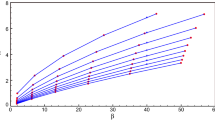Abstract
The two-body additive approximation on the time-dependent Liouville distribution, first introduced in part I of this series, is put into the conventional form of a self-contained kinetic equation for the doublet distribution. From this point of view the approximation consists in truncating the BBGKY chain by expressing the triplet distribution as a functional of lower distributions at the same value of the time variable. To accomplish this, it is necessary to study two associated purely spatial integral equations. The doublet kinetic equation can then be written in terms of solutions of these integral equations and comparison with conventional methods of truncating the BBGKY chain can then be made. For the purpose of comparison a method of truncating the chain based on the Kirkwood superposition approximation is introduced and discussed briefly. The momentum structure of the resulting doublet kinetic equation is similar, but the nonlocality in space of our truncation introduces distinct differences in the spatial structure. The inconsistency between conventional truncations and the exact initial conditions used for the calculation of time-dependent correlation functions is pointed out. This inconsistency is not shared by the two-body additive approximation.
Similar content being viewed by others
References
E. P. Gross,Ann. Phys. (N. Y.) 69:42 (1972).
E. P. Gross,J. Stat. Phys. 9:275 (1973).
E. P. Gross,J. Stat. Phys. 9:297 (1973).
R. Zwanzig,Phys. Rev. 144:170 (1966); M. Nelkin and S. Ranganathan,Phys. Rev. 164:222 (1967); P. J. Ortoleva and M. Nelkin,Phys. Rev. 181:429 (1969).
J. L. Lebowitz, J. K. Percus, and J. Sykes,Phys. Rev. 188:487 (1969).
N. N. Bogolyubov, inStudies in Statistical Mechanics, ed. by J. de Boer and G. E. Uhlenbeck, Interscience, New York (1962), Vol. 1.
A. Lenard,Ann. Phys. (N.Y.) 3:390 (1960); R. Balescu,Phys. Fluids 3:52 (1960); R. L. Guernsey,Phys. Fluids 7:1600 (1964).
R. L. Guernsey,Phys. Fluids 5:322 (1962).
I. Z. Fisher,Statistical Theory of Liquids, University of Chicago Press, Chicago (1964).
B. J. Berne and D. Forster,Ann. Rev. Phys. Chem. 22:563 (1971).
T. Y. Wu,Kinetic Equations of Gases and Plasmas, Addison-Wesley, Reading, Massachusetts (1966).
S. A. Rice and P. Gray,Statistical Mechanics of Simple Liquids, Wiley, New York (1964).
F. H. Stillinger and R. J. Suplinskas,J. Chem. Phys. 44:2432 (1966).
R. G. Mortimer,J. Chem. Phys. 48:1023 (1968).
P. Resibois, inIrreversibility in the Many Body Problem, ed. by J. Biel and J. Rae, Plenum Press, New York (1972).
Author information
Authors and Affiliations
Additional information
Work supported in part by the National Science Foundation under Contract No. NSF GH35691.
Rights and permissions
About this article
Cite this article
Bergeron, K.D., Gross, E.P. & Varley, R.L. Approximate solutions of the Liouville equation. IV. The two-body additive approximation. J Stat Phys 10, 111–138 (1974). https://doi.org/10.1007/BF01009716
Received:
Issue Date:
DOI: https://doi.org/10.1007/BF01009716




